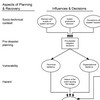What influences the disruption profile?
In a previous post on transport network resilience by Mattson and Jenelius, I was struck by a figure they had taken from this paper. It was a disruption profile, used time and again by a number of researchers within resilience, vulnerability, reliability and related subjects.
In this particular paper the shape of the disruption profile is influenced by two variables: robustness and rapidity. Robustness, in turn, is influenced by mitigation, while adaptation influences rapidity. As a concept this makes sense.
More interesting than the above figure is the construct behind it, illustrated in the form of a flowchart, showing how the influence of mitigation and adaptation comes into play:
At the top of the figure is the socio-technical context. Here are the variables that affect the decisions as to how much pre-disaster mitigation that is required (e.g. by law or based on prior experience), how much that is desired (e.g. risk acceptance) or how much that is economically viable (budgetary constraints).
Following the mitigation decision, at the next level, the system’s vulnerability is determined by another set of variables: the system’s technical resilience, and the organization’s organisational resilience and how they meet the next variable, which is a particular hazard.
Combined, technical and organisational resilience determine the immediate operational capacity following an event, depending on the hazard causing the event. That is the system’s robustness.
After the immediate operational capacity has been established, adaptation decisions must be made as to how to regain full operational recovery, the speed of which is a system’s rapidity in getting back to normal.
The evaluation of pre-disaster and post-disaster decisions and actions initiates a learning process that in turn leads to a new socio-technical context.
In essence, pre-disaster mitigation fosters robustness, and post-disaster adaptation fosters rapidity.
Conclusion
This paper clearly outlines a conceptual framework where resilience, a combination of both rapidity and robustness, is a result of ex-ante and ex-post decisions. Albeit resilience in common thinking more often than not is linked to how an organisation copes with an event ex-post, much of the groundwork for the coping process is laid ex-ante.
Reference
McDaniels, T., Chang, S., Cole, D., Mikawoz, J., Longstaff, H. (2008) Fostering resilience to extreme events within infrastructure systems: Characterizing decision contexts for mitigation and adaptation. Global Environmental Change 2 (18), 310–318
Author links
- researchgate.net: Tim McDaniels
- researchgate,net: Stephanie Chang
- researchgate,net: Joseph Mikawoz
- researchgate.net: Holly Longstaff
- researchgate.net: Darren Cole
Related posts
- husdal.com: Transportation Network Resilience
In this particular paper
